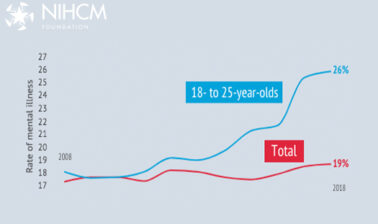Infographics
Youth Mental Health: Trends and Outlook
Published on: January 28, 2020. Updated on: February 22, 2021.
About the Data Insights
This infographic explores mental health trends among youth, teens and young adults, including rising rates of mental illness and suicide. Mental illness is increasingly common in young people and may persist throughout their lifetime, as 75% of all lifetime mental illness develops by age 24. Rates of mental illness are rising faster among 18- to 25-year-olds than the rest of the adult population, which is largely driving the overall increase in rates of mental illness in the U.S.
Mental illness is also underdiagnosed and undertreated, particularly among young people. Less than 50% of 12- to 25-year-olds who reported a major depressive episode within the previous year received treatment, as compared to 70% for people over the age of 26. Mental illness is also a risk factor for suicide, which increased among all young people between the ages of 10 and 24 between 2000 and 2017. Suicide is now the second leading cause of death in this age group.
Prevalence Rates - Any Mental Illness: SAMHSA, 2018 National Survey on Drug Use and Health. Table 10.1B – Any Mental Illness in Past Year among Persons Aged 18 or Older, by Demographic Characteristics: Percentages, 2008-2018
- NOTE: Any Mental Illness can include anxiety disorders, psychotic disorders and symptoms, mood and adjustment disorders, emotional and behavioral disorders, eating disorders, and personality disorders.
Lifetime Mental Illness Percentage: “Lifetime prevalence and age-of-onset distributions of DSM-IV disorders in the National Comorbidity Survey Replication,” Arch Gen Psychiatry, 2005
Anxiety Prevalence: U.S. Department of Health and Human Services, National Institute of Mental Health. (2017). Any Anxiety Disorder.
Rates of Major Depression: SAMHSA, 2018 National Survey on Drug Use and Health. Table 10.32B – Major Depressive Episode in Past Year among Persons Aged 18 or Older, by Demographic Characteristics: Percentages, 2005-2018
Depression is Underdiagnosed in Children and Adolescents: Children's Hospital of Philadelphia
Major Depression Treatment Rates:
- Age 12-17: SAMHSA, 2018 National Survey on Drug Use and Health. Table 11.4B – Receipt of Treatment for Depression in Past Year among Persons Aged 12 to 17 with Major Depressive Episode in Past Year, by Demographic Characteristics: Percentages, 2004-2018
- Ages 18-25 and 26+: SAMHSA, 2018 National Survey on Drug Use and Health. Table 10.34B – Received Treatment for Depression in Past Year among Persons Aged 18 or Older with Major Depressive Episode in Past Year, by Demographic Characteristics: Percentages, 2009-2018
Mental Illness is a Risk Factor for Suicide: According to the CDC, research has found that 46% of people who die by suicide had a known mental health condition. National Alliance for Mental Illness (NAMI) provides a list of other things may put a person at risk of suicide, including:
- A family history of suicide
- Substance abuse - drugs can create mental highs and lows that worsen suicidal thoughts
- Intoxication - more than 1 in 3 people who die from suicide are under the influence of alcohol at the time of death
- Access to firearms
- A serious or chronic medical illness
- Gender - although more women than men attempt suicide, men are nearly 4x more likely to die by suicide
- A history of trauma or abuse
- Prolonged stress
- A recent tragedy or loss
Suicide Death Rate by Age Group: CDC, National Center for Health Statistics, Death Rates Due to Suicide and Homicide Among Persons Aged 10–24: United States, 2000–2017
Suicide as Second-leading Cause of Death: CDC, Leading Causes of Death by Age Group, United States - 2016
Suicide and LGBT Youth: The Trevor Project, National Survey on LGBTQ Youth Mental Health 2019
Strategies to Improve Mental Health:
- HHS, Resources to Support Adolescent Mental Health
- Mayo Clinic, Teen Depression, Diagnosis and Treatment
- NOTE: Complementary/alternative medicine may include relaxation techniques, meditation, yoga and art therapy, among other practices. Mayo Clinic notes that these therapies should not be considered a replacement for conventional medical treatment or psychotherapy but that these methods may be helpful when used in addition to medication and psychotherapy.
Strategies to Improve Suicide Prevention:
- American Psychological Association, Teen Suicide is Preventable
- Trust for America’s Health, Pain in the Nation Series - Building a National Resilience Strategy Addressing a Crisis: Cross-Sector Strategies to Prevent Adolescent Substance Use and Suicide
- ReportingonSuicide.org, Recommendations for Reporting on Suicide
Regis College - Guide to Mental Health Screening in Schools
More Related Content
See More on: Behavioral Health | Maternal and Child Health

